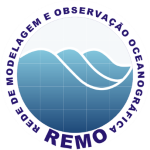Forecast date and time
Select a product
Meteogramas Modelos Numéricos
Selecione o horário das rodadas disponíveis dos modelos, o modelo, então aparecerão as áreas disponíveis e então o local.
Settings
Use the controls below to increase and decrease speed and width of wind movement on the map.
In certain areas and times, wind may be at low speed. By increasing the speed and increasing the width, it is possible to better observe some phenomenons.
Use the control below to increase or decrease the player's loop time.
If it is on, at each zoom in or out, the system will increase or decrease the amount of displayed flows.
REMO
The Oceanographic Observation and Modeling Network (REMO) is a Brazilian effort in physical oceanography and operational oceanography conducted by a group of researchers, technicians and students associated with universities, research centers and the Brazilian Navy, funded by Petrobras and the National Agency of Petroleum, Natural Gas and Biofuels ( ANP).
The overall goal of REMO is the development of science and technology in physical oceanography, ocean modeling, observational oceanography and operational oceanography with data assimilation.

ICON Model
O The Icosahedral Nonhydrostatic Weather and Climate Model (ICON) is a joint project between the German National Meteorological Service (DWD) and the Max Planck Institute for Meteorology (MPI-M) for the development of a unified global numerical weather forecasting system and state-of-the-art climate modeling. The ICON model was introduced into DWD's operational forecasting system in January 2015. DWD and MPI-M pursue ICON development together with the following partners:
- The Institute of Meteorology and Climate Research (IMK) and German Climate Computing Center (DKRZ) - both also from Germany;
- The Swiss National Computing Center (CSCS) - Switzerland;
- The Consortium for small scale modelling (COSMO) - several countries; and
- The Climate Limited-area Modelling Community (CLM) - several countries.
ICON at the CHM
The CHM started operating the non-hydrostatic regional version of the ICON model, adapted for forecasts in a limited area, called ICON-LAM, since mid-2022. Currently, two forecasts are made per day, one at 00 UTC and the other at 12 UTC. The model uses data from the ICON GLOBAL model, with 13 km of horizontal resolution, as initial and boundary conditions. The forecast time of the ICON-LAM is 120 hours (5 days) and its grid was set to a horizontal resolution of 6.5 km, with 50 vertical levels."